Rio De Janeiro is a truly astounding city. Nestled in a lush paradise where golden beaches meet towering green mountains and tropical forests, it is a destination that seems to reveal new wonders at every turn. It is hard to imagine anywhere on Earth that has more to see and experience in one place. If you’re planning a visit to Rio De Janeiro with kids, get ready for a journey where every step reveals something extraordinary.
Imagine strolling from the bustling metropolitan downtown to the glorious beaches in mere moments. Turn a corner, and you’ll find yourself in the quiet serenity of a botanical park with spectacular views of majestic mountains. Rio effortlessly weaves together contrasts – from the opulence of high-end shopping streets to the vibrant life of its famous favelas.
Life in Rio de Janeiro is a tapestry of culture, history, and diverse neighbourhoods. When you are used to the sensible, orderly cities of Europe and the US, with our tedious planning restrictions, visiting Rio feels like having your brain turned inside out. Its chaos is part of its charm, and embracing this way of life is the key to enjoying Rio. Rio is by no means a perfect city, but everything it does, it does with flair and passion.
Join us as we explore Rio’s wonders through a family-friendly lens, uncovering the energy that makes this city a treasure trove for children to explore.

Being Safe In Rio de Janeiro With Kids
Rio’s vibrant streets offer an incredible experience when exploring with kids, but parts of the city undeniably carry a certain reputation, especially considering its areas of extreme poverty.
That said, we found everyone incredibly welcoming and friendly with our children. At no point did we feel worried about their personal safety beyond perhaps crossing some busy roads. Instead, our focus was on safeguarding our belongings, especially in bustling areas.
Even though things have certainly improved since our first visit back in 2008, it still makes perfect sense to take some basic precautions when exploring this incredible town:
- Use Reliable Transport – Opt for official taxis when travelling with kids. In our experience, they are licenced, clean, air-conditioned and secure. We also never had any issues with the meter not being turned on. Although the traffic was often at a standstill, we found taxis readily available and a stress-free mode of transport with the girls.
- Teach Your Children Basic Safety Measures – Instruct your kids on essential safety measures, such as not talking to strangers and staying close to you in crowded areas. Consider asking your children to wear wristbands with emergency contact information. We go into more detail on this in our article on safety tips with kids here. In Rio in particular, we made sure the girls kept their belongings close to them.
- Pack Only the Essentials When Exploring – Remember to bring essential items like sunscreen, water, snacks, and any necessary medications for your kids. Watch out for signs of heat exhaustion and sunstroke.

- Stay out after dark, but not too long – When the sun sets, Rio comes alive, and the energy on the street is incredible. In the first hour or so after sunset, there is almost a carnival atmosphere as children play and their parents relax and catch up with friends and family. Certainly, this is something to experience, but we would not recommend staying out too late.
- Watch out for a strong undertow on some of the beaches – Some of the beaches, especially at Ipanema, have powerful waves that can sweep adults off their feet and pose a risk of dragging a child out to sea. When your children are playing in the sea, keep a close eye on them and position yourself near the lifeguard stations. We found the waves at Copacabana and Praia Vermelha were safer for the children to play at the water’s edge, but you still need to be wary of rip tides/undercurrents.
- Don’t Flash The Cash – Keep phones, wallets, and purses in a zipped bag or pocket. Avoid wearing expensive watches or jewellery. While major attractions have a police presence, exercise caution in the city, keeping phone use discreet. We left our wedding rings back in the UK, and Adrian’s battered old G-Shock is as flashy as we get.

- Don’t Take a Bag to the Beach – Even if it only has a towel in it, it is tempting for thieves.
- Secure Items Left in your Hotel Room – Most accommodation should offer a safe to store passports and other items, but if not, consider investing in a PacSafe-style bag. It will not thwart a determined thief but will certainly deter opportunists. Link to pacsafe
Getting Around Rio de Janeiro With Kids
The traffic in Rio feels like the perfect expression of Chaos Theory in motion. In the UK, traffic is like a game of Tetris. Everything has its own space and rules and usually slots neatly together. In Rio, traffic is more like a river. Cars, trucks, and bikes move in a fluid manner, appearing to defy the laws of physics as they seamlessly glide between lanes and occupy spaces that, by all accounts, seem too tight.
Even when the traffic is gridlocked (which is most of the time), it is not stationary. Motorbikes cut up between the lanes of traffic and seem to treat red lights as mere suggestions rather than as actual requirements to stop.

We would not recommend hiring a car in Rio. Even as a driver with more than 20 years of experience in various countries, the chaotic traffic in Rio can be downright intimidating. To make matters worse, it looks like there are only about four car parking spaces in the entire city.
Rio’s terrible traffic is compounded by its geography, which makes a much-needed underground mass transit system impossible. Although beautiful, The mountains surrounding the city make building new highways and digging tunnels costly and laborious.
The most convenient and reliable mode of transportation for navigating Rio with children is the official yellow taxi. We used them to get all over the city, and even a long journey from one end of town to the other was a little over 60 Reals, with most short journeys costing no more than 30 Reals. Yes, you will still sit in traffic with your children, but at least you will be sitting in traffic in an air-conditioned vehicle going exactly where you want to go.
Just about all the official taxis we used were clean and well-maintained. We never had any of the classic arguments about turning on the meter, and they nearly all accepted payment by card.
We tried a few times to get an Uber but could only find the moto-taxi kind. These are motorbikes you cling to the back of; close your eyes and hope for the best as you zoom through the traffic. Fun if you are travelling solo and have a gentle death wish, but not great for kids in tow!
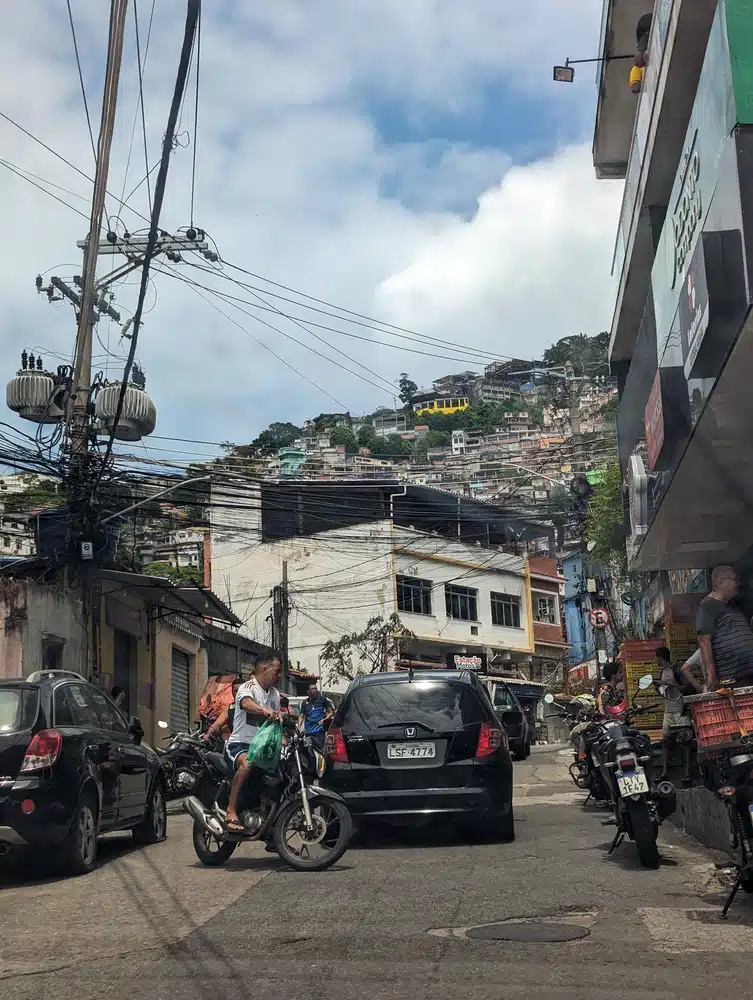
Navigating Rio’s revamped tram system, a post-Olympics addition, offered a pleasant experience, especially in the city’s western reaches. Once we deciphered the ticket machine, where the English translation had taken a detour, we discovered that trams provided a clean and enjoyable mode of public transportation. The service was punctual, and the routes were reasonably straightforward.
Eating In Rio de Janeiro With Kids
As you would expect for a major city, Rio has just about anything and everything you could want to eat, even for the pickiest child. Although we enjoyed the restaurants, I think the entire Spencer clan agrees that the real highlight was the street food!
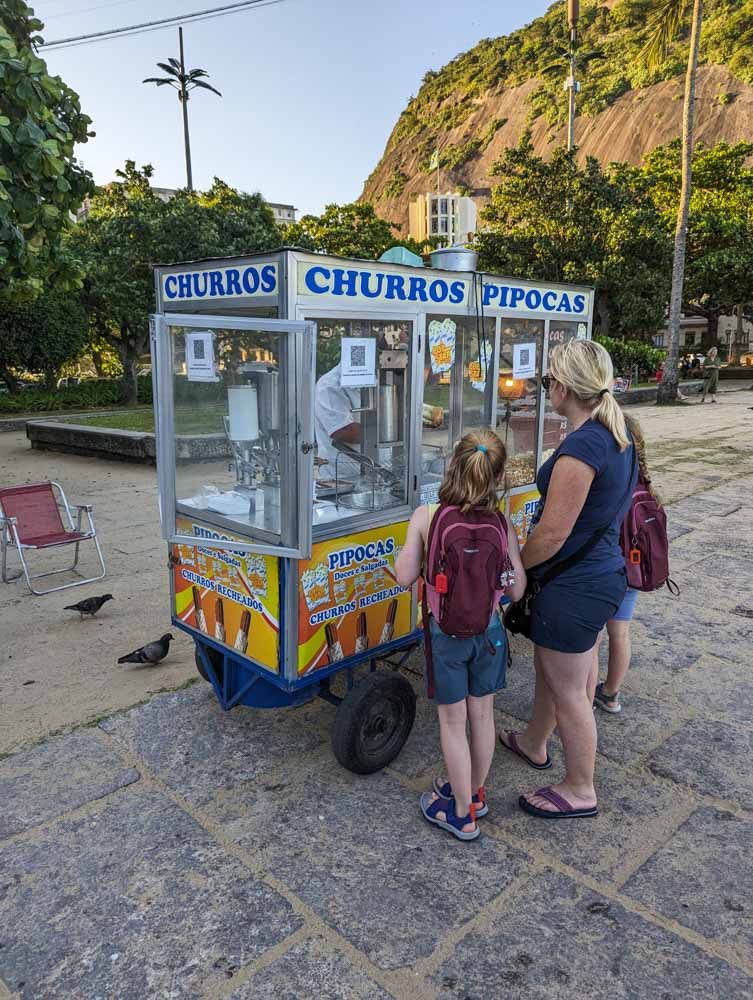
If you are in Rio, you must try some of these delights. A big hit was the stands that sold bowls of fresh corn soused in butter and salt. Another hit was the churros stands, which put the chocolate sauce inside the churros rather than on top (revolutionary!) We also had several hamburguesas and empanadas for a quick and easy lunch.
Beyond that, you will find all the typical fast food joints plus an incredible range of restaurants.

Getting Past Rio’s Language Barrier
Although we have a grasp of basic Portuguese, we did find the language barrier quite profound in Rio. We managed to muddle through with what we knew in Portuguese, Spanish and Google Translate, but we rarely found anyone who spoke English except at the big tourist attractions.
Certainly, we would recommend learning some basic phrases before you go and installing the Google Translate app, which was a lifesaver! Another tip is to download Portuguese on the app before you leave home in case the internet fails you.
Getting Online
To avoid horrendous roaming charges, we typically buy a local SIM card when we arrive somewhere new. However, we were surprised to find that there was no place in Rio de Janeiro’s airport to get one!
This turned out to be a bit of an unexpected game-changer as it pushed us to try an e-sim, which, it turns out, is a lot more versatile. They can be downloaded and installed before you get on the plane, they can cover entire regions rather than just a country, you get instant updates to how much data you have left, and you can easily top them up with extra data.
We used an app called Airalo to get ours, and they have been reasonably priced and reliable.
Everyone uses WhatsApp to call and message in South America, so make sure you have it installed before you go. WhatsApp also has a built in translation function which has been incredibly useful.
Where to Stay With Kids In Rio de Janeiro
Choosing the right accommodation in Rio de Janeiro is crucial when travelling with kids. We suggest staying in family-friendly neighbourhoods like Copacabana or Ipanema. These neighbourhoods offer beautiful beaches, great food, and a myriad of activities, although do expect a tourist tax.
If your children are a bit older, then Santa Teresa is also an option – but not recommended if you have a young one in a pram! Set on steep hills, it has a charming village feeling and is close to some of the big attractions but a modest taxi ride from the beach,
If hotels are not your thing, then some great apartments are available which provide a more homely feel and often come equipped with kitchens, making family meals a breeze.
The crazy thing about this town is you can spend as much as you would like. We have seen places from 240 Reals a night to 3000!
Things To Do In Rio de Janeiro With Kids:
Ipanema Beach and Copacabana Beach

I honestly wonder how anybody gets anything done in Rio de Janeiro.
I just couldn’t imagine trying to do a day’s work and making it to even 11 am before deciding that, actually, what we should do is go down to the beach with our friends and family, drink a Caipirinha and let the kids run riot in the waves.
The beaches are not just places to tan your cheeks and watch the beautiful people; they are more like the centre of the community. All human life is here, with families, friends, and lovers, young and old, enjoying these beautiful spaces.
Of the two famous beaches, we found Copacabana to be the best to visit with kids purely because of how strong the waves were on Ipanema. As we mentioned above, on Ipanema, the powerful waves break right on the shore and create a fierce undertow capable of pulling a child out to sea. To underline this, the day before we arrived in Rio, there had been a ‘sneaker wave‘ which flooded the beach, pushing tonnes of sand up onto the road.

At Copacabana Beach, the waves break about 20m from the beach, so you get a much more gentle swell that rolls to the shore. The girls spent hours playing there and made some “beach friends” as well, despite barely sharing a word of common tongue.
When you first walk onto either of the beaches, it can feel a little overwhelming. Every 20m or so, there are beach vendors who hire out deck chairs and parasols and can provide you with drinks as well. They are certain to see you coming and will rush up to offer their services.
These stands do not own the beach and you do not have to use their facilities. Unlike in certain parts of Southeast Asia, they will happily take “no” for an answer and we saw many people simply sat on their beach towels enjoying the sun and surf.
If you do want to take advantage of their services, make sure you ask to see a price list before you sit down. We didn’t know this, and we were moderately ripped off on our first visit, so learned this the hard way. When we sat with a more reputable vendor, the next day we paid 15 Reals per chair we hired and 30 Reals for a parasol – a small price for comfort! The cost of drinks was slightly inflated but not terribly so.
Also, we asked to sit close to the sea so we could watch the girls as they played, and they were happy to oblige.
When it comes to refreshments, a gentle stream of people walk up and down offering everything from back massages to cocktails, crisps, freshly BBQed meat, hair braiding, hamburgers, prawns, and the ubiquitous bowls of buttered corn.
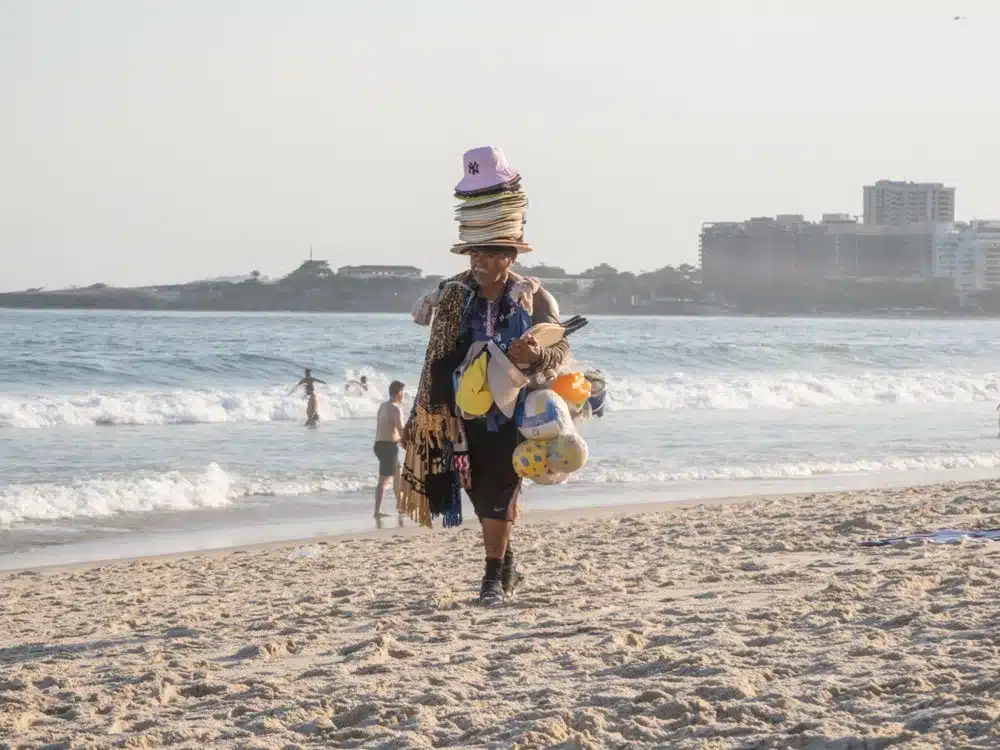
We tried all sorts of things to eat (including the ambient temperature prawns, and no, I don’t know what we were thinking but amazingly we had no ill effects). Don’t be afraid to haggle with the vendor, especially if you feel the tourist tax is too egregious.
No trip to Rio would be complete without a couple of afternoons on these world-famous sands; just be wary about overdoing the sun, especially if you have just arrived from colder climates. Warnings aside, our time spent on the beach was some of our most enjoyable!
Sugarloaf Mountain and Morro da Urca

Sugarloaf Mountain is where we fell in love with Rio.
Far above the hubbub of this thriving metropolis, Sugarloaf Mountain is a welcome respite of peace and calm, offering stunning vistas of the city. Our family trip up this iconic mountain was probably our favourite experience of our entire time there.
The journey up via the gorgeous Morro da Urca costs 160 Reals per adult and 80 per child. Although you can usually buy tickets on the day, the queue can be long, especially in peak season, so we would recommend pre-booking.
A quick heads up for families: hang on to your cable car tickets! You’ll need them for all four parts of the journey, up and down, so don’t discard them after the first journey like we nearly did!
The queue for the cable car is airconditioned and moves quickly; you should find yourself on the way up in no time.
On both Morro da Urca and Sugarloaf, there is a wide choice of places to grab a bite to eat (albeit slightly overpriced – but not overly so compared to some other tourist traps), several shady spots with seats to enjoy a picnic if you have brought one, and much to explore.

Both mountains have short jungle walks. During ours, we encountered marmosets who took a strong interest in our lunch! Also, Morro da Urca has a honey garden with different sorts of bees and a memory game, which is worth spending a few moments exploring.
Sugarloaf undoubtedly has genuinely amazing views and really brings home just how wildly unfeasible a city Rio really is. Our only complaint was we had to fight past all the people spending half an hour taking countless selfies just to get a simple family photo. Despite the occasional selfie scuffle, the summit has plenty of space and doesn’t feel overcrowded.
There is a walking trail up Urca Hill, and whilst it might entice adventurous adults, we would not recommend it to families with young children. It is a steep, long climb in very humid conditions. Aside from this, Georgia and Eva were so excited about going in the cable car that it made it a no-brainer for us. Choose your adventure wisely!
It’s worth noting that if you do opt for the trail, you still need to buy your tickets to continue up to Sugarloaf Mountain at the base, as they aren’t available for purchase at the second level.
Finally, near the arrival station of Morro da Urca, there are some interesting glimpses into the history of the cable car up to Sugar Loaf Mountain. There are different generations of cable cars on display with a quick history rundown. A ride on the original version must have been a wild experience! There’s also a small pod with neat videos and pics summing up the cable car’s story.
Sugarloaf is not quite enough to fill a full day, but as you head down, you may notice the beautiful little beach of…
Praia Vermelha – Red Beach
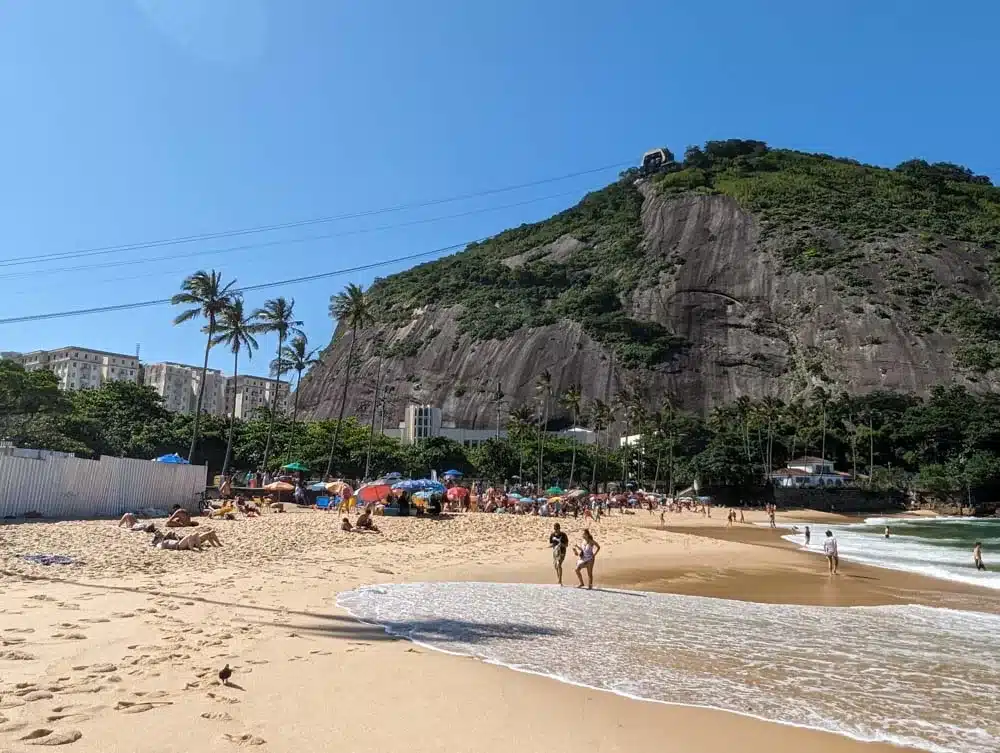
Tucked away under Sugarloaf, this stunning little beach is the perfect spot to relax and unwind with your kids. Its shore, with its reddish sands, is protected by headland, so you usually get gentle waves.
Unlike Copacabana, we didn’t bother paying for chairs here; instead, we set up camp in a patch of shade under the walls of Terra Brasilis at the south end of the beach.
The sea is much calmer here than in Ipanema or Copacabana, and while it doesn’t quite have the fairytale white sand, it was perfect for Georgia and Eva to play in. In fact, it was the first time the girls could really play in the sea without a slight concern about being swept away! It is worth mentioning, however, that there were visible patches of rubbish near the shore edge. We are not sure if this is a regular occurrence or just how the tides fell that day.
There are all the usual vendors you would expect for food, such as bowls of fresh corn, fruits, hamburgers and churros.
Pista Cláudio Coutinho
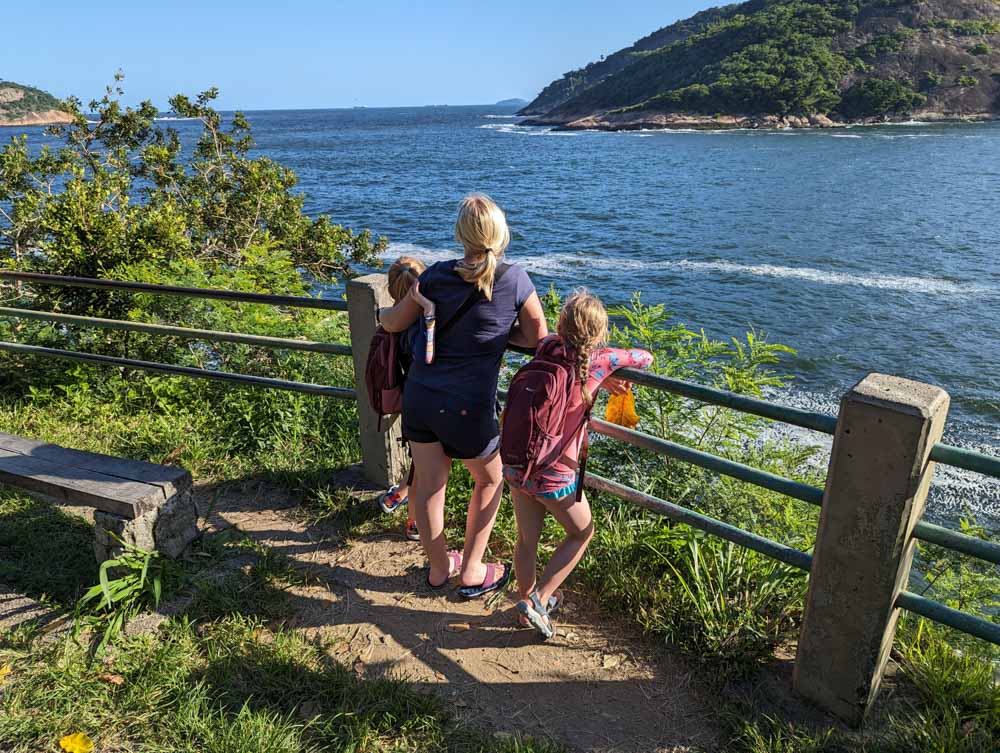
Just next to Praia Vermelha is a short but delightful path called Pista Cláudio Coutinho. This shady, wide hiking trail follows the coast and takes you around the side of Sugarloaf through some beautiful jungle.
The walk is nearly all flat and takes a little over an hour to complete there and back. The sea breeze and natural beauty make it a great way to unwind after a wonderful day.
Museu do Amanhã – Museum of Tomorrow

If you are looking for something to do to fire your children’s imagination (and perhaps get out of the mid-day heat!), then the Museum of Tomorrow is a wonderful place to spend a very relaxed afternoon with your kids.
Set inside one of the coolest buildings we have ever seen, the museum tackles a whole range of topics, from the origins of the cosmos to the development of human society in a very child-friendly way. The museum has been designed to accommodate multiple languages, and the interactive exhibits encourage children to learn at their own pace.
We absolutely loved the Galatic Portal—so much that we went through it twice! It is located at the top of the stairs after purchasing your tickets, it can get quite busy so there may be a small queue. The exhibit features a brief video showcasing the universe’s evolution from the Big Bang to the present day. Projected in 360 degrees on the dome’s internal wall, the immersive experience is something else. While you can sit normally, we’d suggest lying down on the floor mats for the full impact.
Another great exhibit was an extraordinary photo gallery that draws parallels between diverse cultural traditions worldwide. This display explores everything from weddings and libraries to cooking and New Year celebrations, offering one of the museum’s most profound experiences. Stepping into the cube, the ingenious use of mirrors creates a sense of eternity. It beautifully underscored the idea that, regardless of our origins, we are all global citizens with much more in common than makes us different.

The museum also does not shy away from the current challenges facing humanity, especially the accelerating impact of humankind on the environment since the 1950s. Covering topics like our carbon output, increasing fertiliser usage, and destruction of wild habitats puts a sharp underline on the fact that there is no Planet B.
There are some very clever interactive screens which, with the use of your entry card, you can answer questions inscribed in your local language. The girl’s favourite one was a set of questions on your carbon footprint to determine how many worlds you need to live in your current lifestyle.
There is a café and restaurant on-site for food and drinks, which are subject to a gentle tourist tax. Outside is the usual array of much cheaper food carts and drinks vendors, but be warned, you can’t exit the museum and return without paying again. Entrance cost 30 Reals per adult and 15 per child, and we spent a little over 3 hours at the museum. It was well worth the journey.
Escadaria Selarón – The Lapa Steps
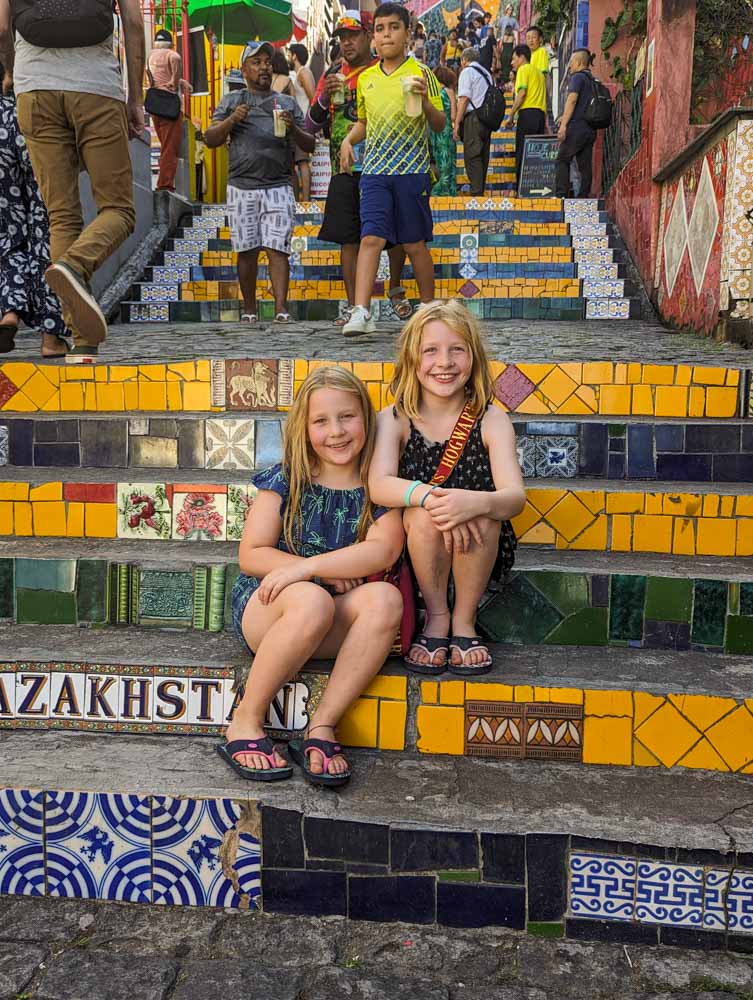
The Lapa Steps, connecting the neighbourhoods of Santa Teresa and Montserrat, have become an iconic symbol of the city’s cultural richness. Created by Chilean artist Jorge Selarón as his “tribute to the Brazilian people”, the steps have been featured in music videos, TV shows and movies. Selarón declared that as a work of art, the steps would never be complete until the day he died. The steps feature over 2000 tiles, many of which were donated from all around the globe.
Each step tells a story, creating a mesmerizing visual journey that reflects the diversity and unity of the people who visit. It’s a must-see for anyone exploring Rio’s artistic tapestry.
Located just a short tram journey from The Museum of Tomorrow, we spent around half an hour at the steps. The stairs are genuinely beautiful and really capture the spirit of what Rio has to offer. As ever, there is the usual selection of tourist tat available, but we found no one to be pushy, and it didn’t take away from the joy of visiting the steps.
The only complaint was the number of TikTok and Instagram users clogging the place up. How long does it take to pull a pouty face to a camera? The length of time each took is, quite frankly, infuriating. If you push past the first couple of flights, the upper steps are quieter.
Cristo Redentor – Christ The Redeemer

The big man himself!
Christ the Redeemer is so famous I will not waste time with any introduction except to say that making the trip to Corcovado Mountain is a must when you visit Rio with your children. However, to put my cards on the table, I would say it was one of the least enjoyable experiences of our visit to Rio de Janeiro with our Children.
To be honest, the plaza under the statue is not big enough for the number of visitors it receives and is in dire need of modernisation. In comparison to Sugarloaf Mountain, it falls a bit short. Nevertheless, being one of the Wonders of the World will ensure enduring popularity. However, we found that admiring the iconic statue from a distance brought us more joy. We had a great time playing ‘Spot the Big Man’ from various points around the city.
Getting To Christ The Redeemer
There are several ways to visit the statue. We decided to take the classic Cog Train from Corcovado Station, which climbs up 710m through the forest, and you are rewarded with some incredible views over the city along the way.
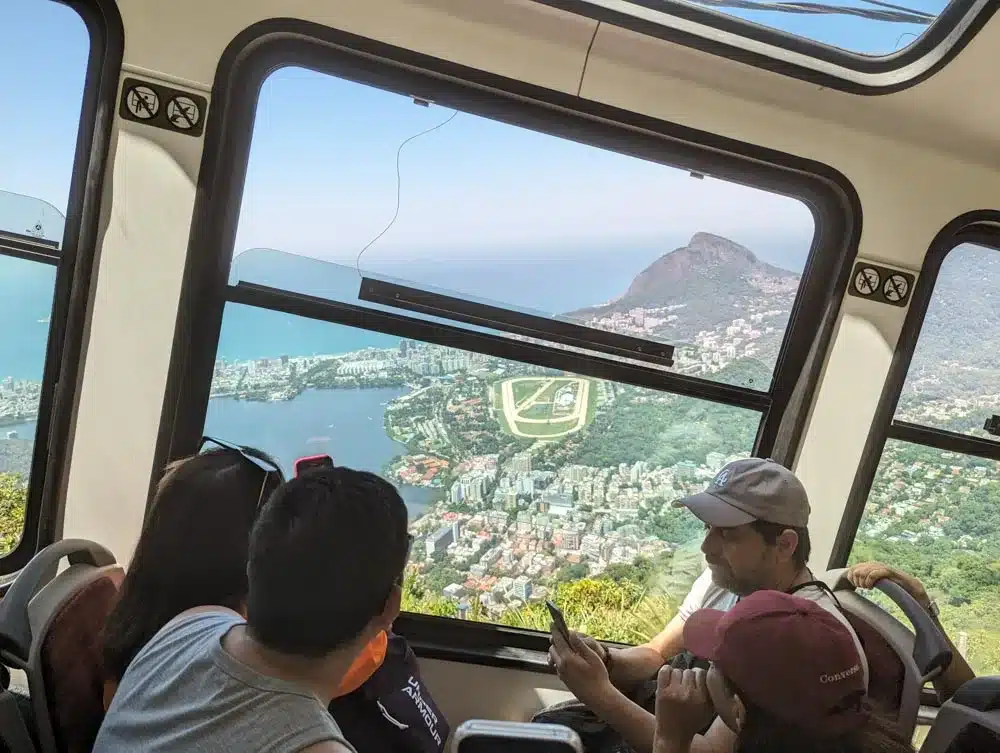
If you want to take the Cog Train with kids, you must pre-book your tickets a day or so before. If you try and purchase tickets from the station on the day, you get put in the general queue, and you could all be waiting for a couple of hours for the train up. Unlike Sugarloaf, the area you wait in is not air-conditioned, and the prospect of being stuck in that baking hot tin box for hours with children does not appeal in the slightest!
Arriving at Corcovado Station is chaotic in that incredibly charming Brazilian way. When you pre-book, you need to provide your passport info and then receive a voucher via email, which you exchange for tickets at the station. When exchanging the tickets, you must show your passport or a copy of it, so be sure to have one with you.
If this seems like a lot, don’t worry. There are plenty of helpful staff members at the station to explain what you need to do.
If you pre-book your slot, ensure you arrive in plenty of time. If you miss your slot (which is entirely possible given Rio’s traffic), you get bumped to the general queue, and again, you could be waiting hours for the trip up the hill.
While the cog train is the classic way to see Christ the Redeemer, it frankly feels antiquated, hot, and insufficient for the number of visitors the statue attracts. It is a stressful experience to do it with children.
The other way to visit the statue is by official van. This is not as romantic, but it is air-conditioned! You can buy tickets online here and hop on the van at either Paineiras Corcovado, Largo do Machado or Copacabana. The van will take you to the Paineiras Visitor Center, where you can catch another van that will take you the rest of the way.
Also, hiking trails lead to the statue, but these are not safe. In 2019, dozens of people were held at gunpoint on the trail in a mass robbery characterised as an ambush. We decided we would give that a miss.
Our final tip for visiting Christ the Redeemer with kids is to get there as early as possible in the day when it is quieter and cooler. As expected, the attraction is fantastically popular, and the crowds peak by lunchtime. The platform in front of the statue is swarming with people, and while this may be acceptable when travelling as a couple, it really is not enjoyable for children who can see nothing but the navels and bums of other tourists.

Again, unlike Sugarloaf, there is little else to do at the statue. There is one overpriced café with a ginormous queue, and the toilets are frankly appalling. There is no reason to stay once you have admired the statue and enjoyed the panoramic views.
Botanical Garden of Rio de Janeiro

A short hop from Christ the Redeemer, the botanical gardens offer a leafy respite far from the maddening crowds of Rio. Established in 1808, as soon as you stroll down its leafy paths, you feel transported to another world. It is a great place to escape the worst of the afternoon heat.
Georgia and Eva loved the gardens, and we spent over an hour spotting the wildlife and meandering through its groves. From an educational perspective, there is not a huge amount of information available in English, but we could understand enough through Google Translate. We got to see a wild toucan, which was the highlight of the visit!
Exploring the gardens comes with an unexpectedly hefty price tag. Each adult admission cost 72 Reals, while it was 36 Reals per child—a cost comparable to our visit to Christ the Redeemer. We have been to similar gardens worldwide, and you are rarely asked to make anything more than a small donation to visit.
An additional inconvenience is that only cash is accepted at the entrance. No one could explain why this is, but seeing as even the tiny food stands and taxi drivers would accept cards, we struggled to see the problem.
The café inside the park (which infuriatingly did accept bank cards!) was the most heinously overpriced refreshments we encountered in Rio. We are all for a little tourist tax, but the cost of four ice-creams and four bottles of water would have been eye-watering in even the most overpriced London bistro.
Centro Cultural – Cultural Center
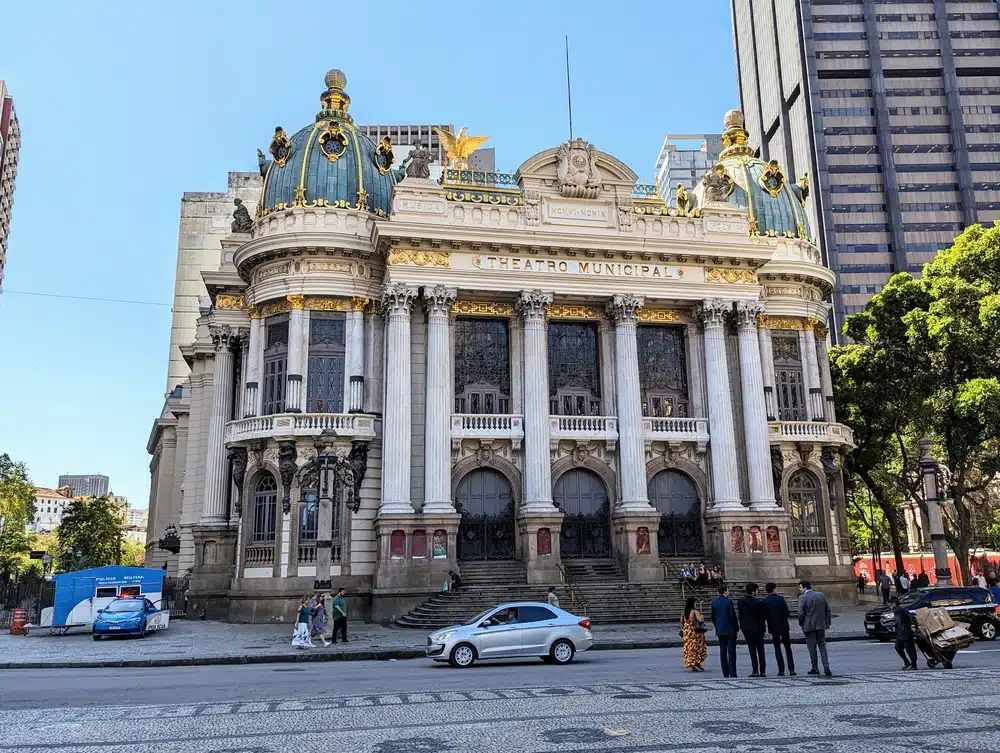
As much a state of mind as a place, Centro Cultural is a feast of architectural splendour. A legacy of the Portuguese heritage of the country, these beautiful historical buildings contrast sharply against the ultra-modern skyscrapers next to them.
The legacy of these colonial buildings is probably a bit much for young children to comprehend, and it may be of limited appeal to them as it is not one of the most exciting activities, but peppered with markets and quaint side streets, it is worth spending an hour walking around them.
Highlights of the cultural centre include Paço Imperial, Chafariz da Piramide, and Centro Cultural Banco do Brasil. We used Rio The Guide’s great self-guided tour.
Aqua Rio

Another great place to escape the heat of the afternoon! This world-class aquarium, situated just up from the Museum of Tomorrow on the Mauá Pier, provides an immersive and educational experience that captivated Georgia and Eva.
Inside, there is a diverse array of marine habitats, carefully curated to replicate the natural environments of its inhabitants. From the bustling energy of a coral reef teeming with colourful fish to the serene beauty of a kelp forest, AquaRio showcases the breadth of marine ecosystems with meticulous attention to detail.
The aquarium is also interactive and does a wonderful job of encouraging the inquisitive nature of young minds through interactive learning experiences. Specifically designed exhibits and touch pools allow kids to engage with marine life, fostering a connection with the und
erwater world. These hands-on encounters create lasting memories and instil a sense of wonder and respect for ocean conservation.
Have We Missed Anything To Do In Rio De Janeiro With Kids?

So there we have our complete guide to Rio De Janeiro with Kids! We hope you find it useful and have as much of an amazing time as we did in this great city!
If we have missed anything or you have any questions, please let us know in the comments below.


Did you feel safe with your kids? Did they stand out with their blonde hair? I keep reading how terrible it is in Rio and unsafe, but I really want to go with my kids. They all speak Portugese, I don’t. Did your hotel feel safe?
Hi Brynn,
Yes, we absolutely felt safe. There was a significant police presence at all the major tourist attractions, so there was no issue. That is not to say we were not careful. We didn’t walk around much after dark and made sure not to flash our phones or anything expensive. We got taxis to most destinations without a problem. We had an incredible time, and we are glad we went!